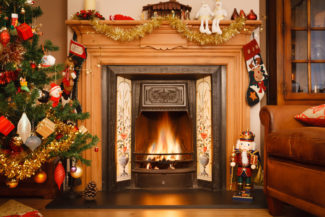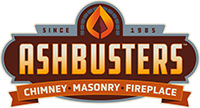Fire safety is important all year long, but around the holidays, there are some special tips to keep in mind.
How can you make sure you and your family stay safe this Christmas and don’t experience a chimney fire or house fire?
 #1 Have your chimney swept and inspected before you use it this holiday season.
#1 Have your chimney swept and inspected before you use it this holiday season.
If you don’t know what kind of condition your chimney is in, you shouldn’t use it. It’s just not worth it. Why?
You may not experience problems at first, but the longer you use your fireplace, the more dangerous it can become if it’s dirty.
You see, when the buildup inside your chimney remains hot for a long period of time, it can combust and easily cause a chimney fire.
Mark Stoner, the founder of Ashbusters, learned that firsthand when he was just 14 years old. His family had a chimney fire on Christmas Eve, and while no one was hurt, the fire damaged the home and turned an otherwise wonderful Christmas Eve into a bit of a nightmare.
Those aren’t the kind of holiday memories you want to create. So stay safe and merry by having your chimney checked by a Chimney Safety Institute of America (CSIA) certified sweep before you light a fire in the fireplace this holiday season. It’s the cheapest fire insurance you can buy!
#2 Don’t burn highly flammable things in your fireplace.
Wrapping paper, cardboard, Christmas tree trimmings…these are materials that burn super hot and can easily ignite combustibles inside the chimney.
That’s exactly what caused Mark’s chimney fire when he was a kid.
The family had opened a few gifts, tossing the wrapping paper, cardboard, and bows into the fireplace when they were done with them. Those materials burned very hot and ignited the combustible buildup inside of the chimney, and voila: chimney fire.
Your fireplace is not a trash incinerator, so never burn anything other than wood (or whatever fuel it’s designed to use) in it.
#3 Keep stockings and other flammables at least three feet away from the fireplace.
Stockings, wrapped gifts, holiday decorations, and other flammable items should be kept at least three feet away from your fireplace.
This is just a good rule of thumb that can prevent flammable items from getting too hot and catching fire when you have a fire going.
#4 Use a spark screen.
Larger sparks can jump out of the fire, land on nearby combustibles, and catch those nearby combustibles on fire. Sparks can also hurt pets, kids, and anyone in the vicinity.
What’s the best way to keep those sparks from starting a house fire or injuring those in your home? Make sure you have a spark screen pulled shut in front of your fireplace.
This will keep those sparks where they belong: in the fireplace.
#5 Keep an eye out for cracks and breaks.
Some of the things that catch fire most commonly are hearths and mantels — but there’s usually a warning sign before a fire breaks out.
Give your fireplace a good lookover and check for cracks, breaks, peeling paint, and discoloration.
Typically, the hearth or mantel will start to discolor as it dries out from the heat of the fire. You may also notice the paint or wood cracking. All of these can be signs of a fire to come, so keep an eye out.
#6 Take notice of excess or consistent smoke.
With a woodburning fireplace, there’s always some smoke. But if the smoke is consistent or you can see it in the air, you may have a leak or something may be smoldering in your chimney.
When we take a chimney apart, it’s not uncommon for us to find charred wood and burned areas that didn’t quite catch on fire, but were about to. Consistent smoke could be a sign of this.
#7 Have your gas vents checked annually and cleaned as needed.
Carbon monoxide poisoning claims thousands of lives a year. To protect your family from this threat, if you have any kind of a gas-burning heating appliance in your home, you need to have the vent checked annually.
It’s not because the vent gets dirty, it’s because the vent is not a static environment. It doesn’t stay the same year after year.
It gets hot, it gets cold, it gets wet, animals build nests in it, it expands and contracts, pieces of pipe separate, brick can fall in and block it…
In other words, it’s not a “dirty” problem, it’s a mechanical failure that can happen over time.
The most dangerous appliance in terms of carbon monoxide threat is a gas furnace. If the vent is blocked, your furnace can put out enough carbon monoxide to kill you.
A gas fireplace can over time, as well, but most people don’t burn their gas fireplace for days and days on end. That said, people have gotten really sick from carbon monoxide poisoning because of a blocked vent on a gas fireplace — and it can take months and months to recover from carbon monoxide poisoning.
So make sure your gas heating appliance vents are checked annually and cleaned as necessary. And don’t forget: you should have a carbon monoxide alarm on every floor of the home and one outside of each sleeping area.
#8 Have your gas dryer vent inspected annually and cleaned as needed.
With gas dryers, the biggest concern is with the heat produced by the dryer and the flammability of lint. Gas dryer vents can catch fire more easily than electric ones because they get hotter.
If you have a gas-powered dryer, have the dryer vent checked annually for lint buildup, and cleaned if needed. That way, you don’t have to worry about a dryer vent fire and the damage it can cause to your home.
Laundry can be a chore, but it doesn’t have to be a threat to your safety.
#9 Have a fire escape plan.
No one wants to plan for the worst, but sometimes you need to. Because once a chimney fire is happening, it’s natural to panic.
A friend of Mark’s had a chimney fire, and the mom and dad went out the front door, while the kids went out the back. The mom thought the kids were still inside, so she ran back into the house to try to find them, and perished.
Meanwhile, the kids were out back wondering where their parents were.
It’s absolutely heartbreaking, but you can prevent the same thing from happening should you have a chimney fire, by making an escape plan.
Have a designated meeting place for your family, so that no matter how you get out of the home, you all meet at the same place and know you’re all safe and accounted for.
It’s a simple plan that can make a big difference should something bad happen.
Well, that about wraps it up. We hope these tips help you and your family enjoy a safer, happier holiday season. Remember, we’re here if you need us!
